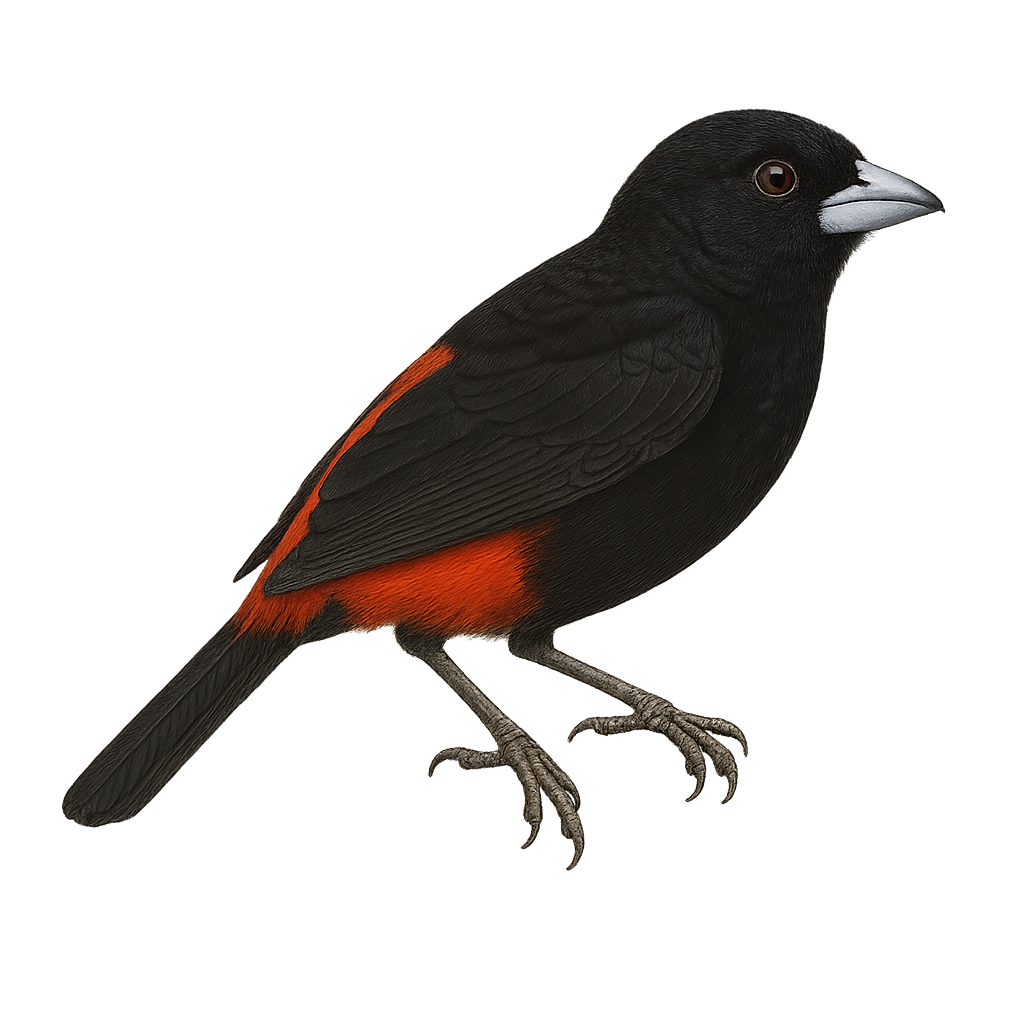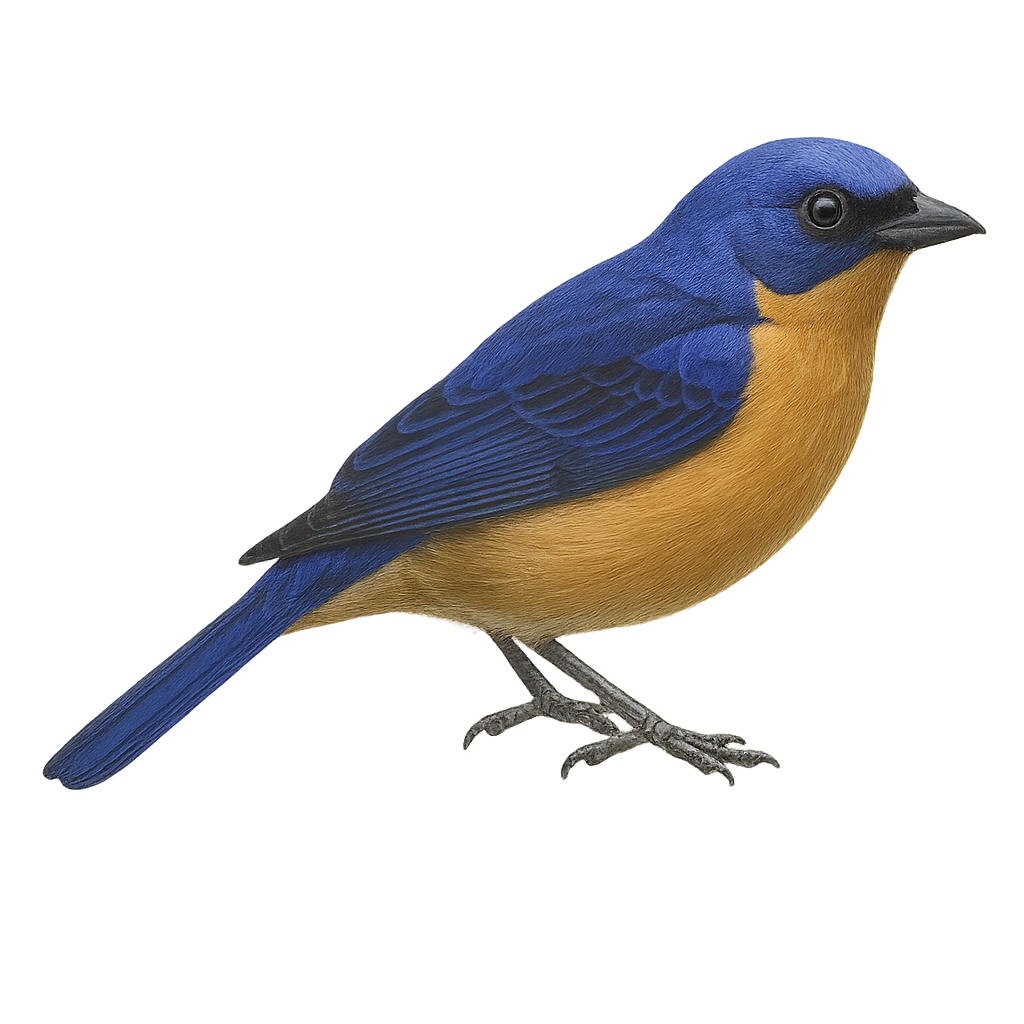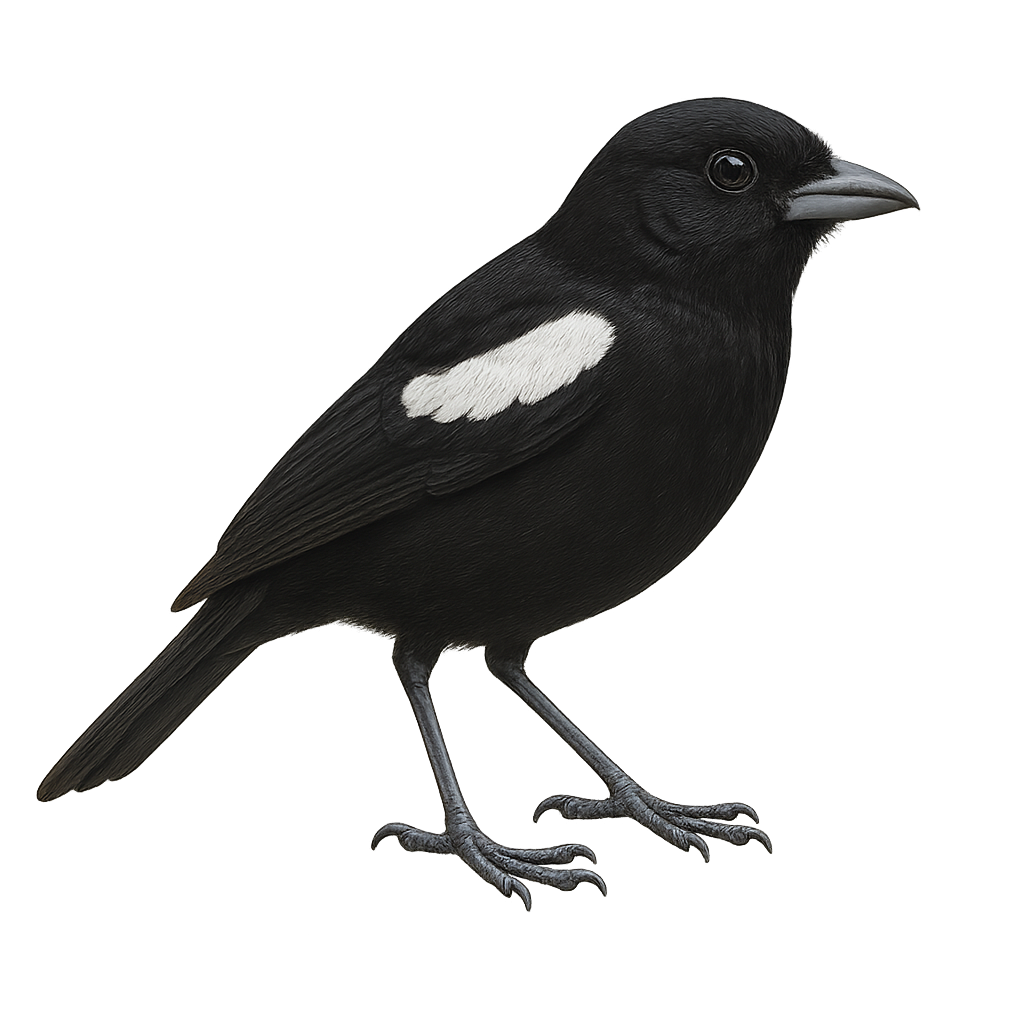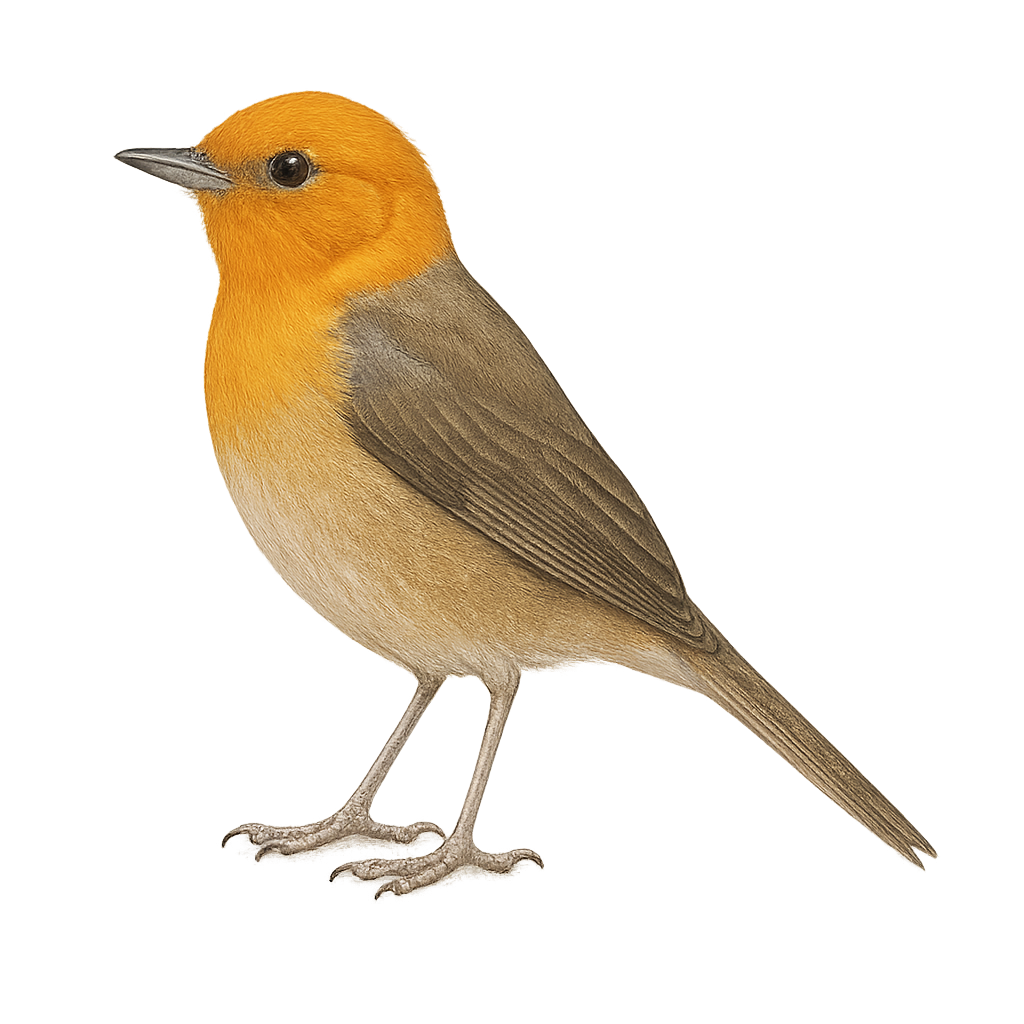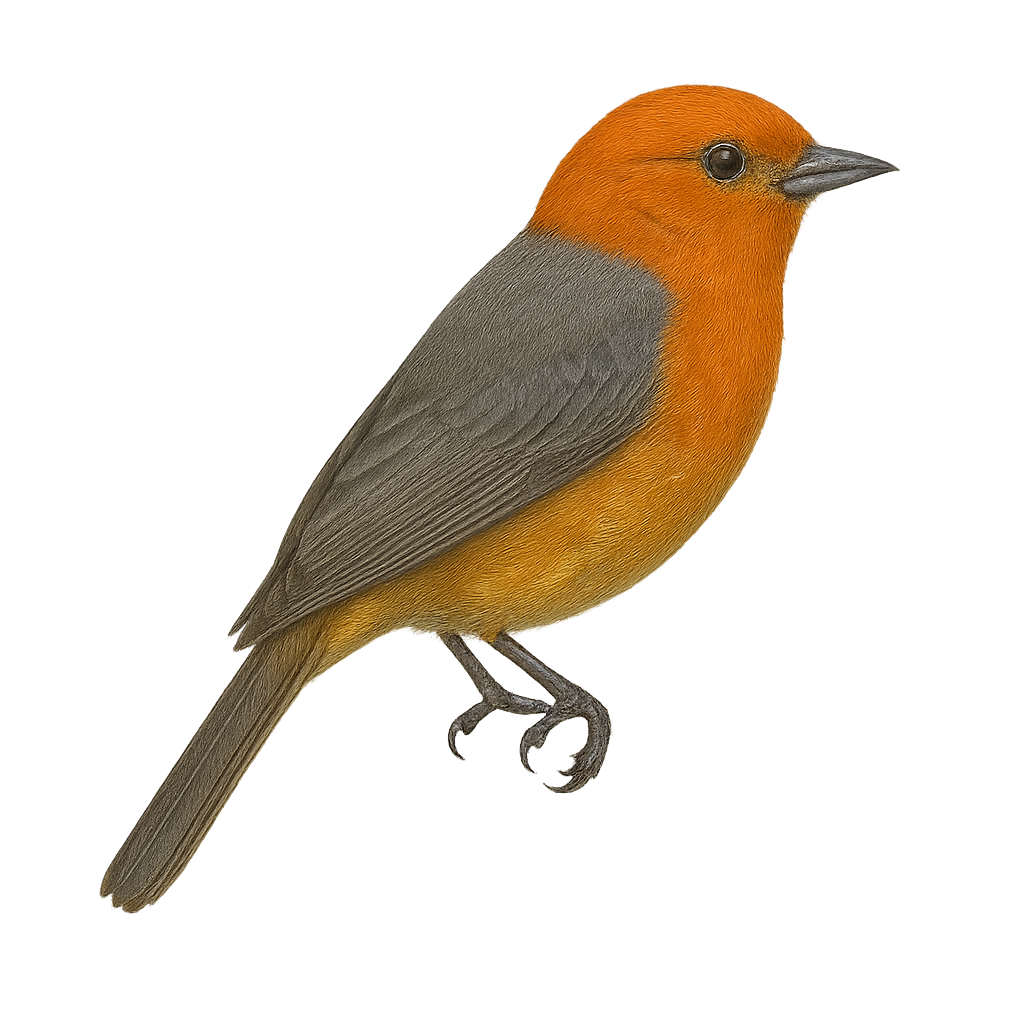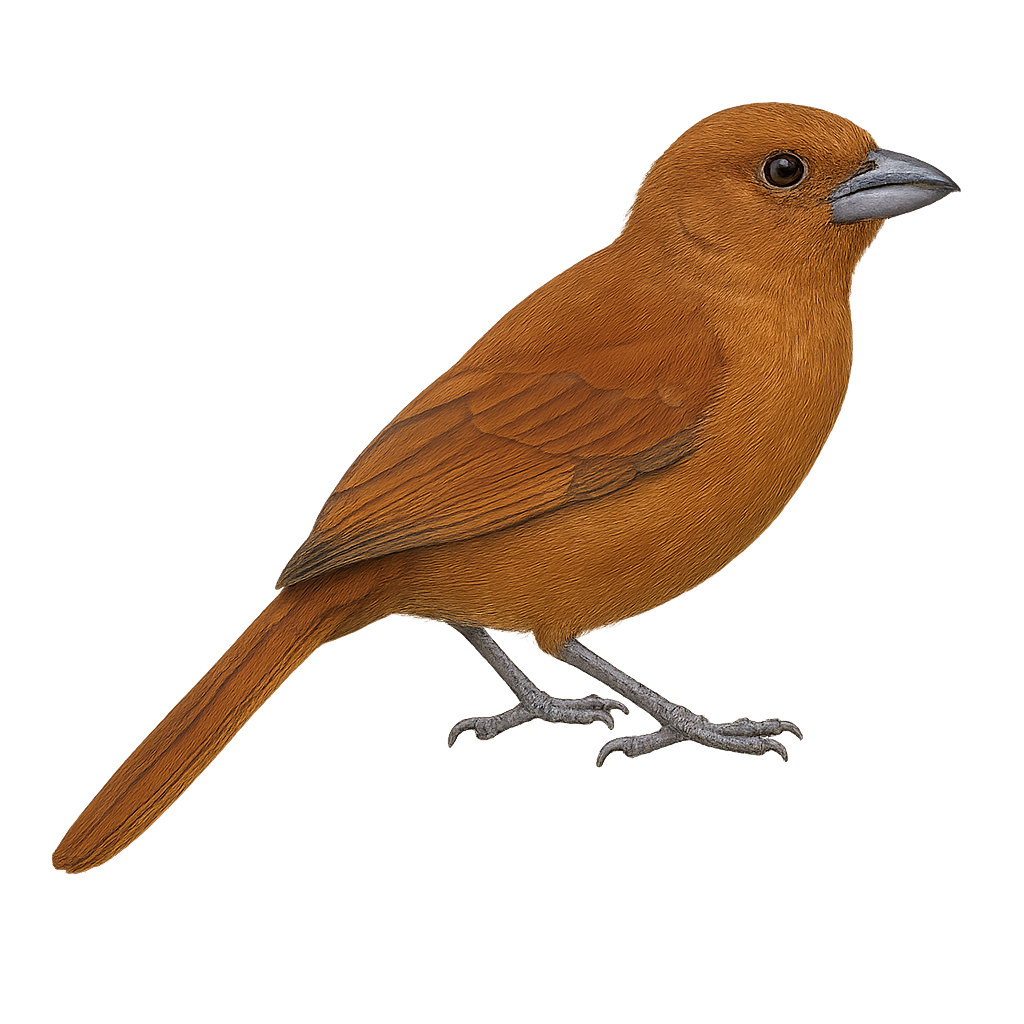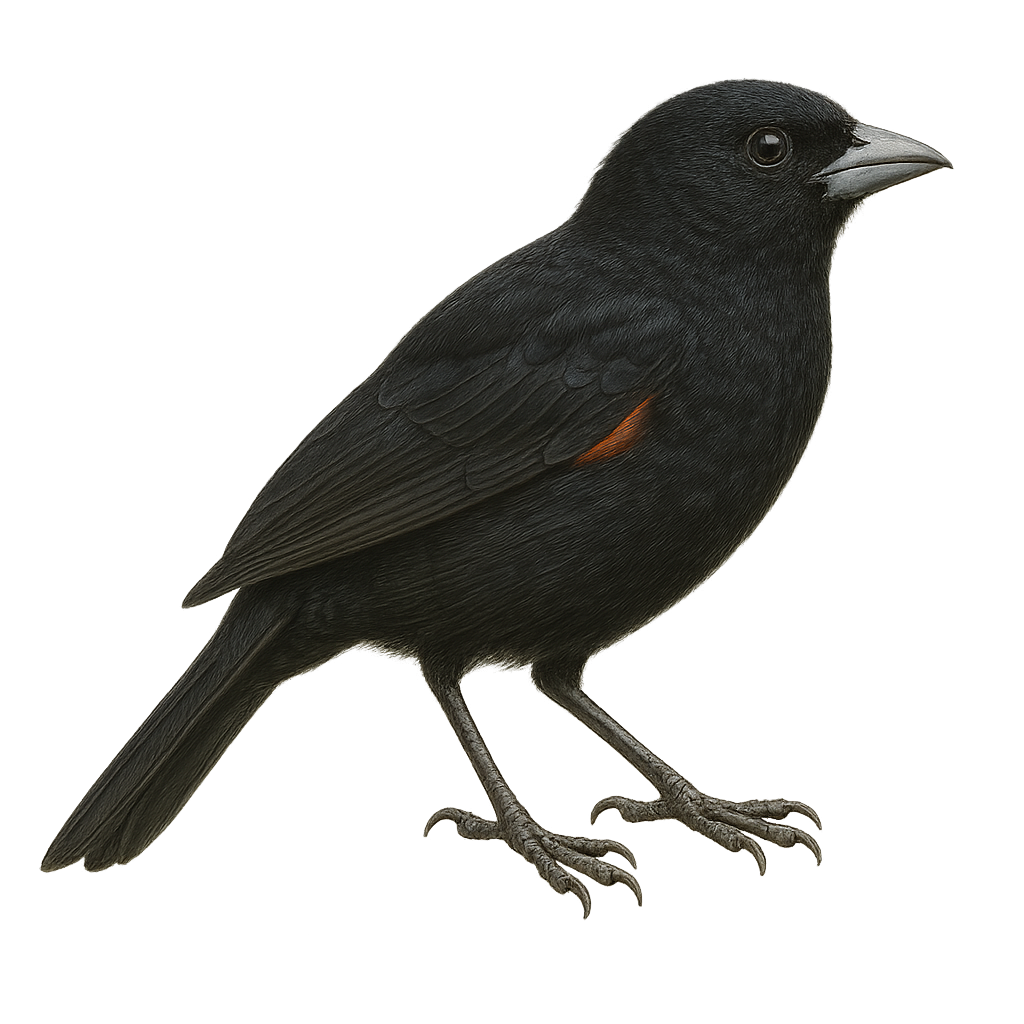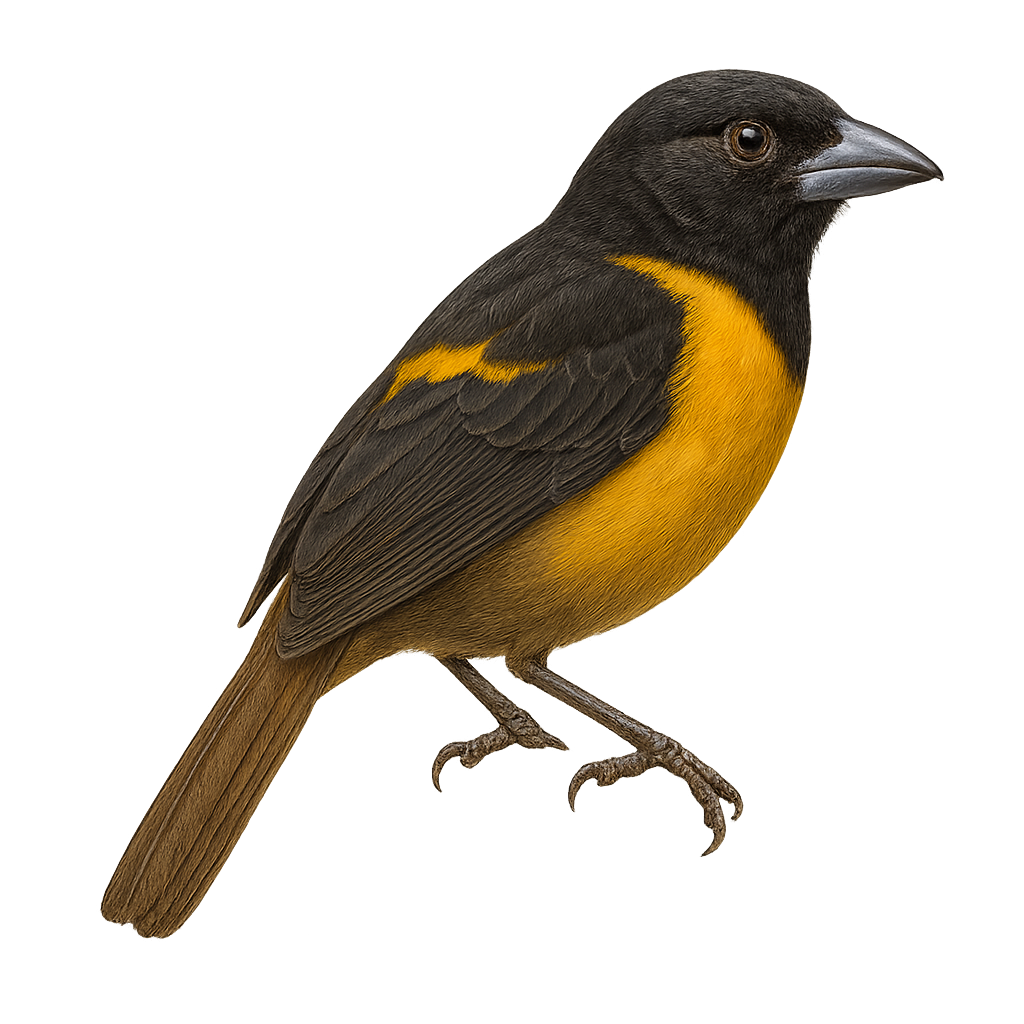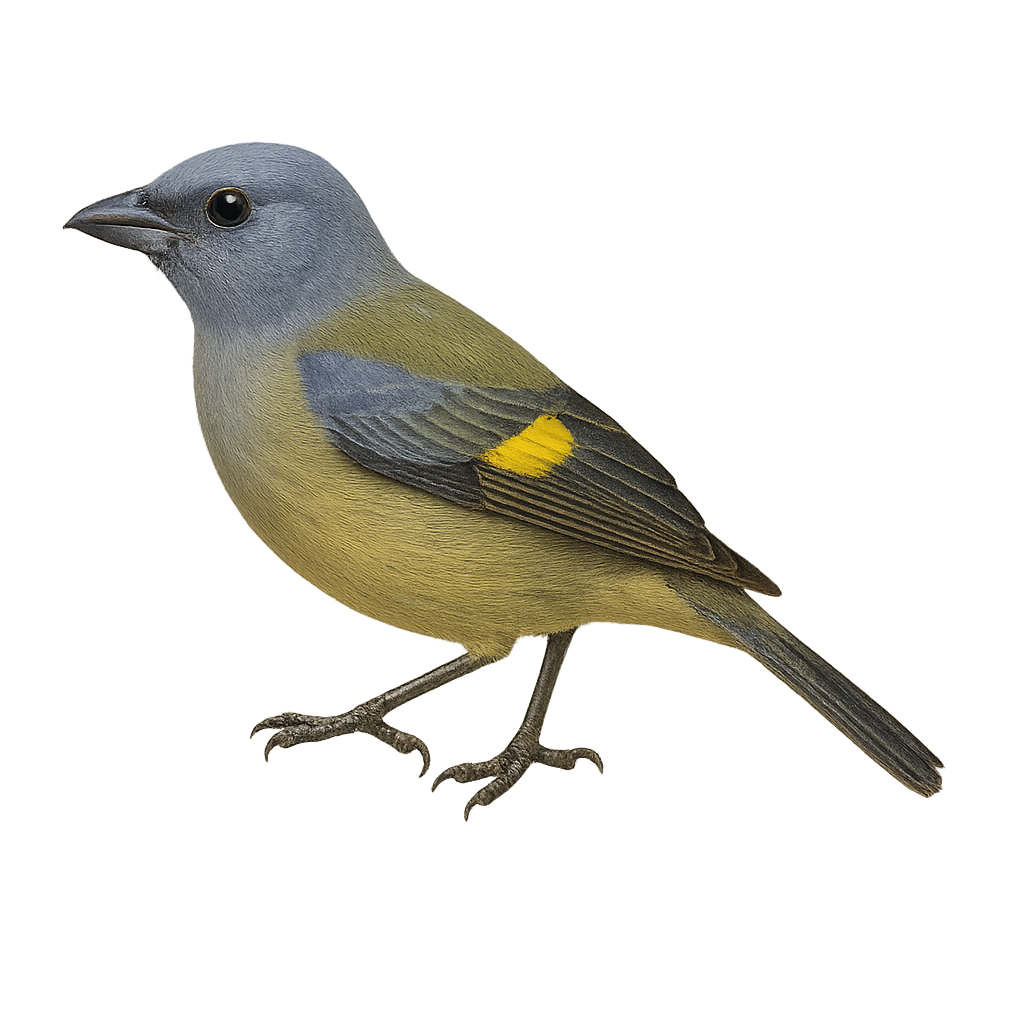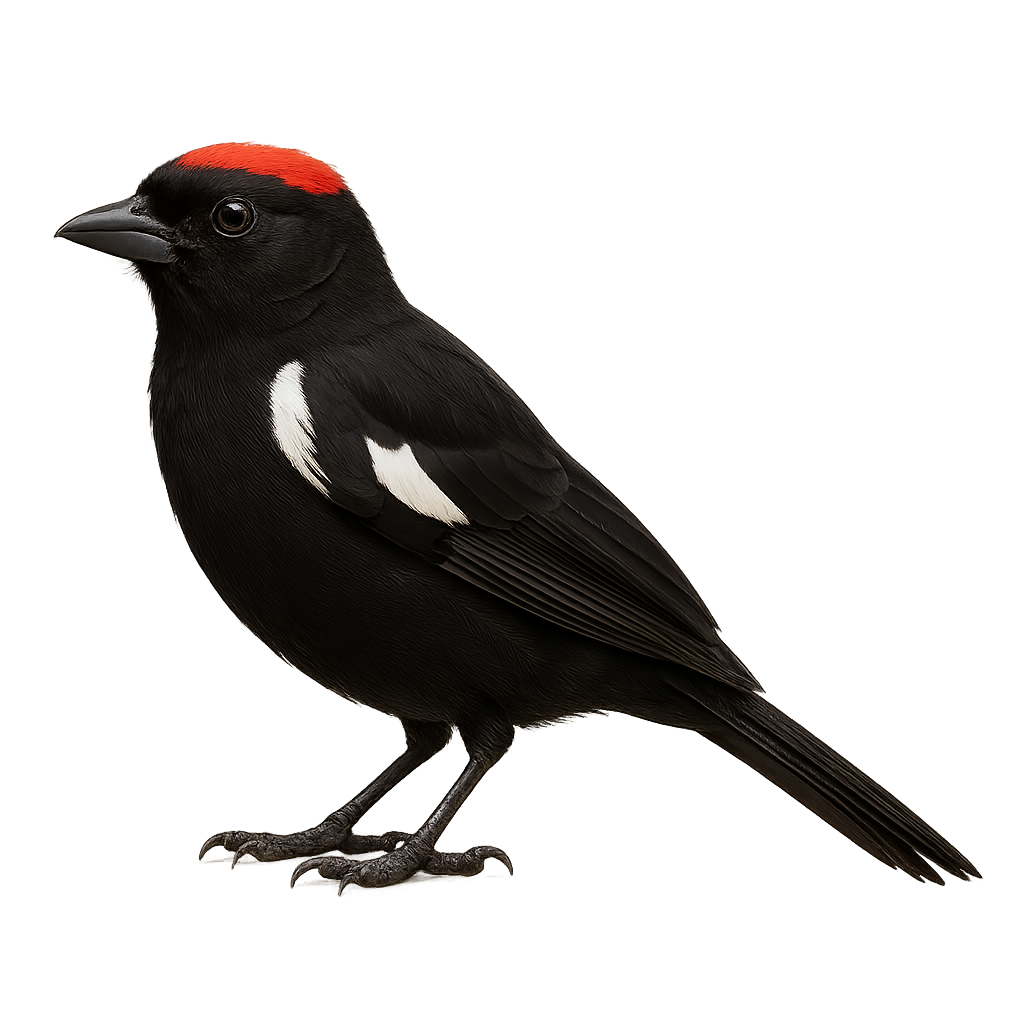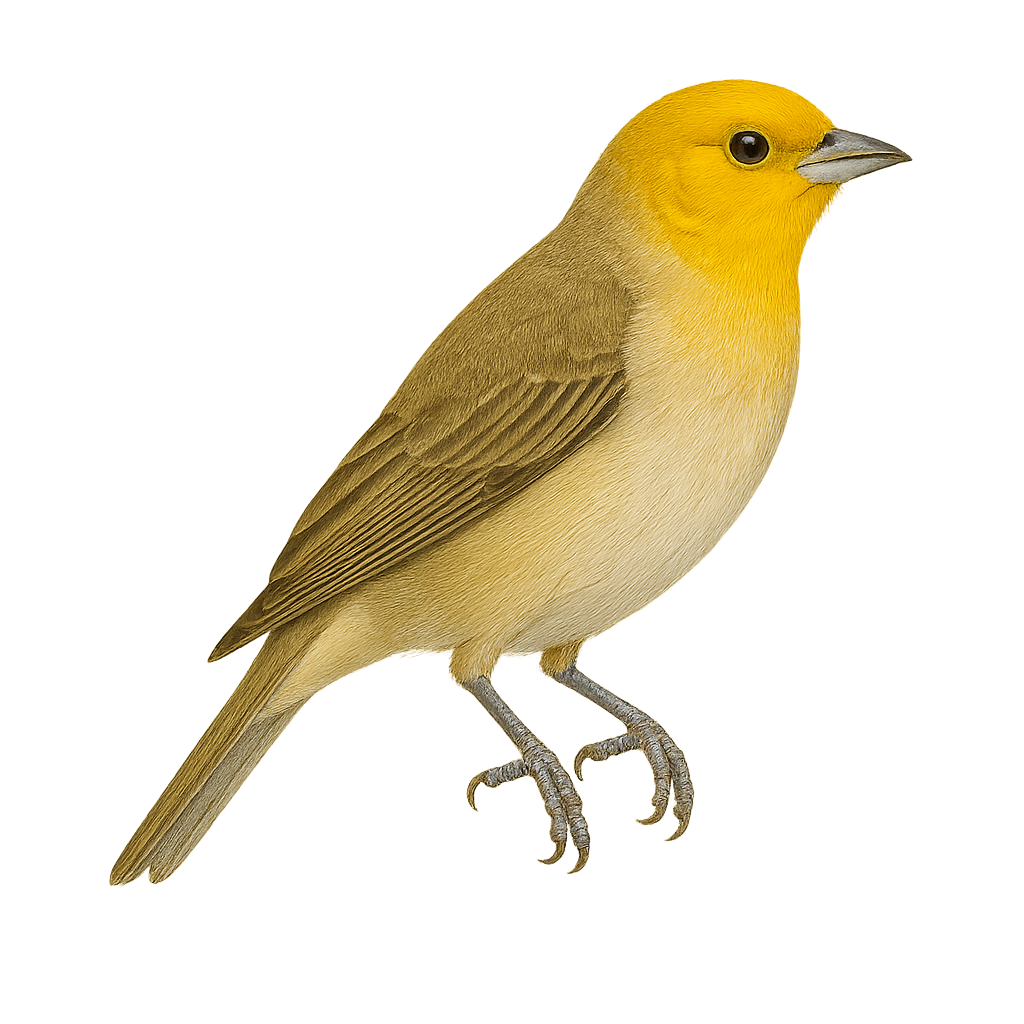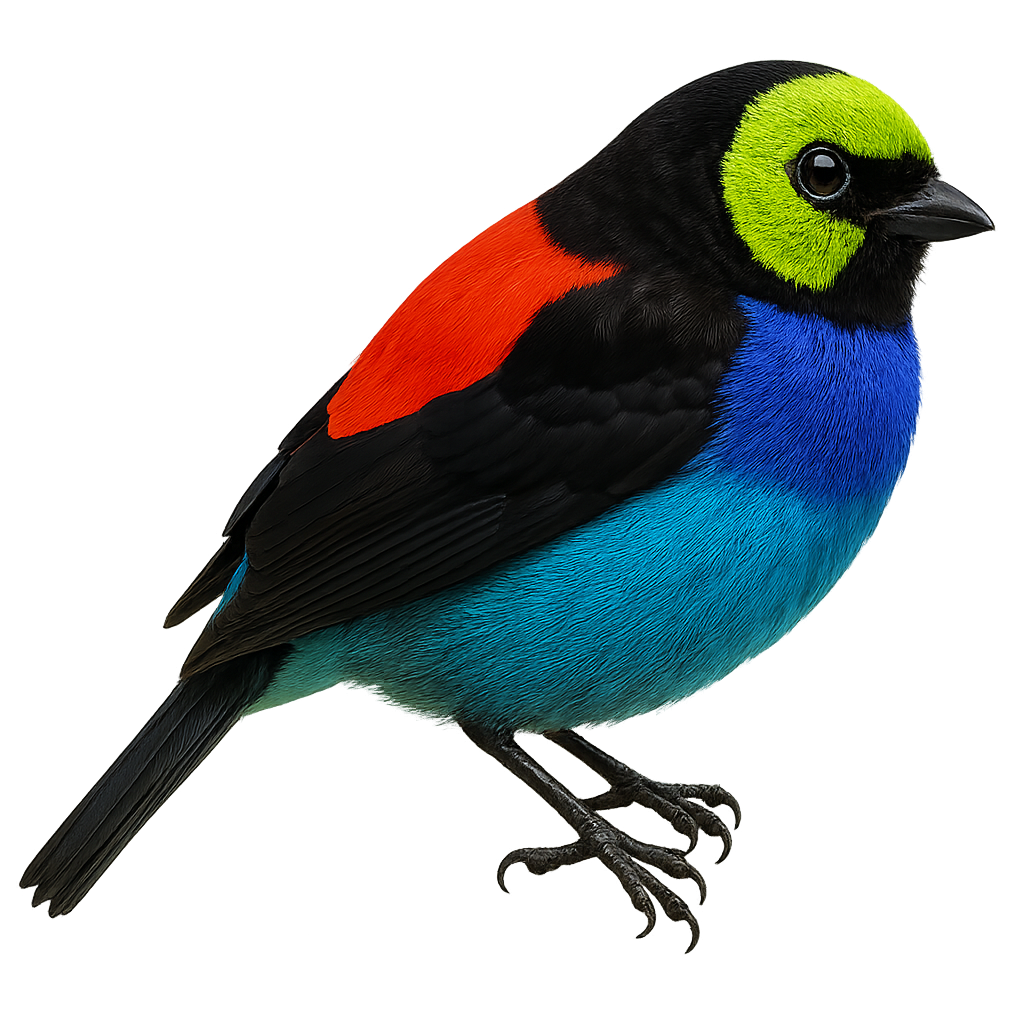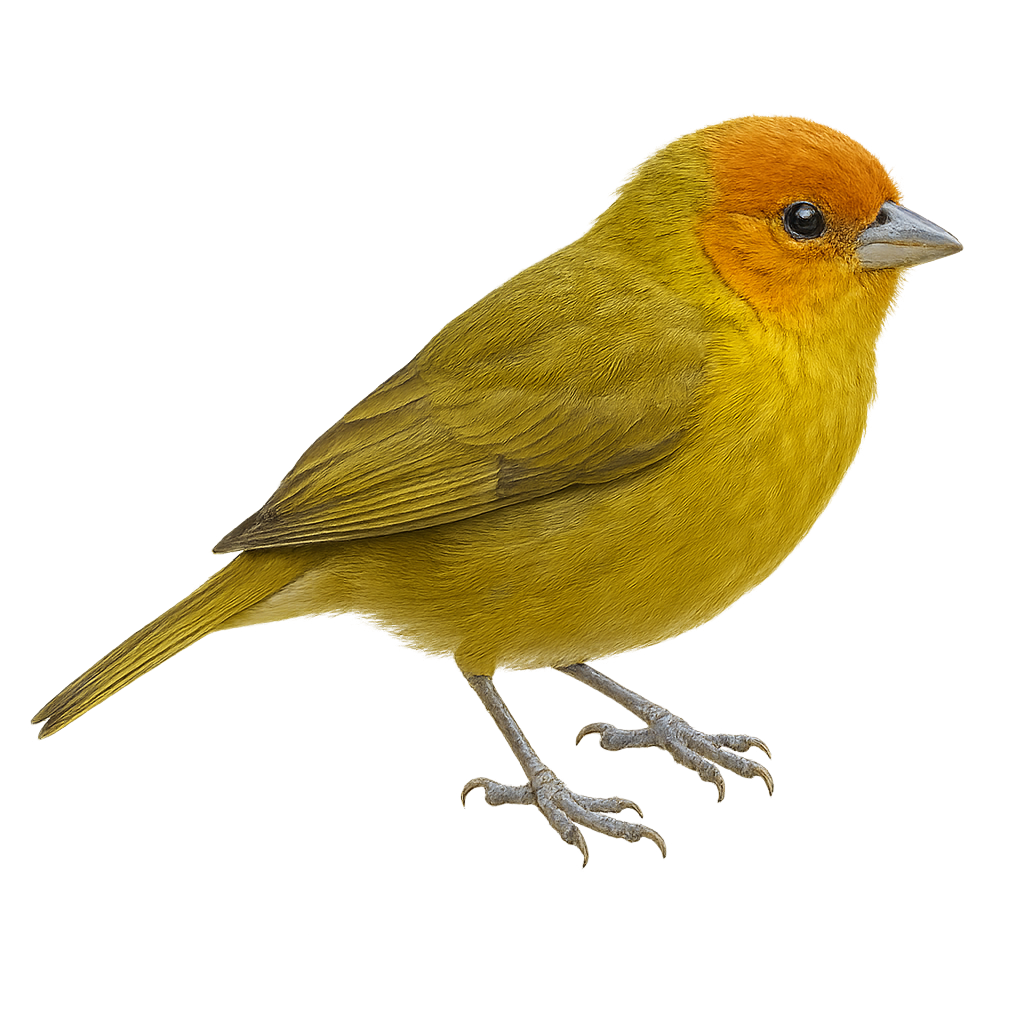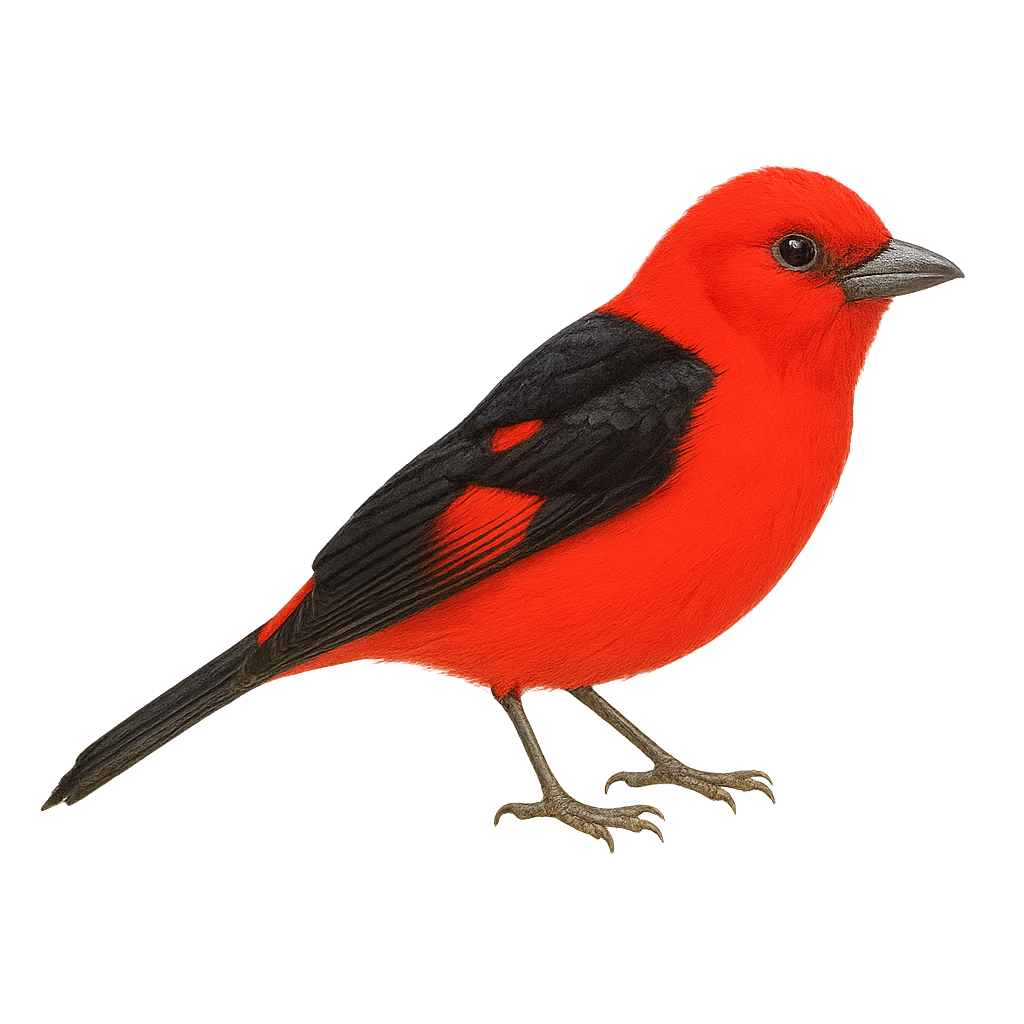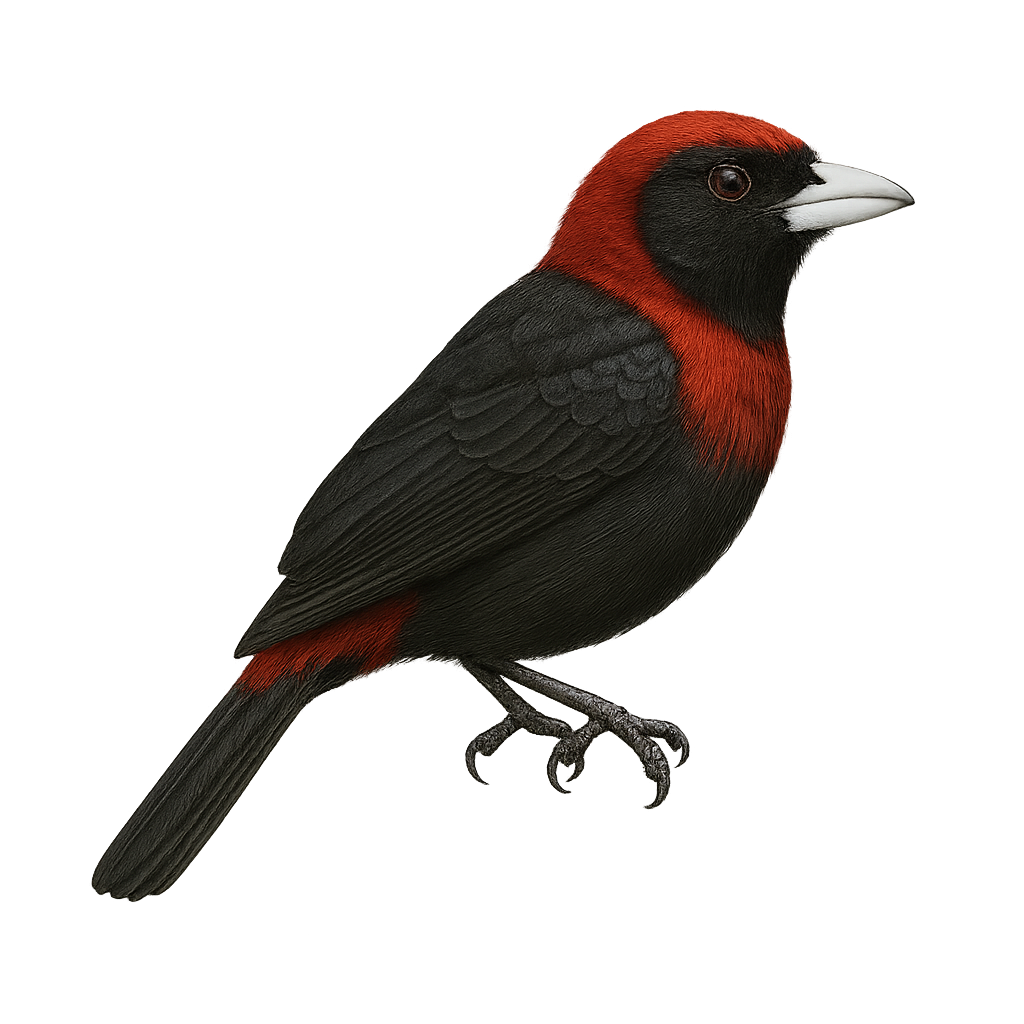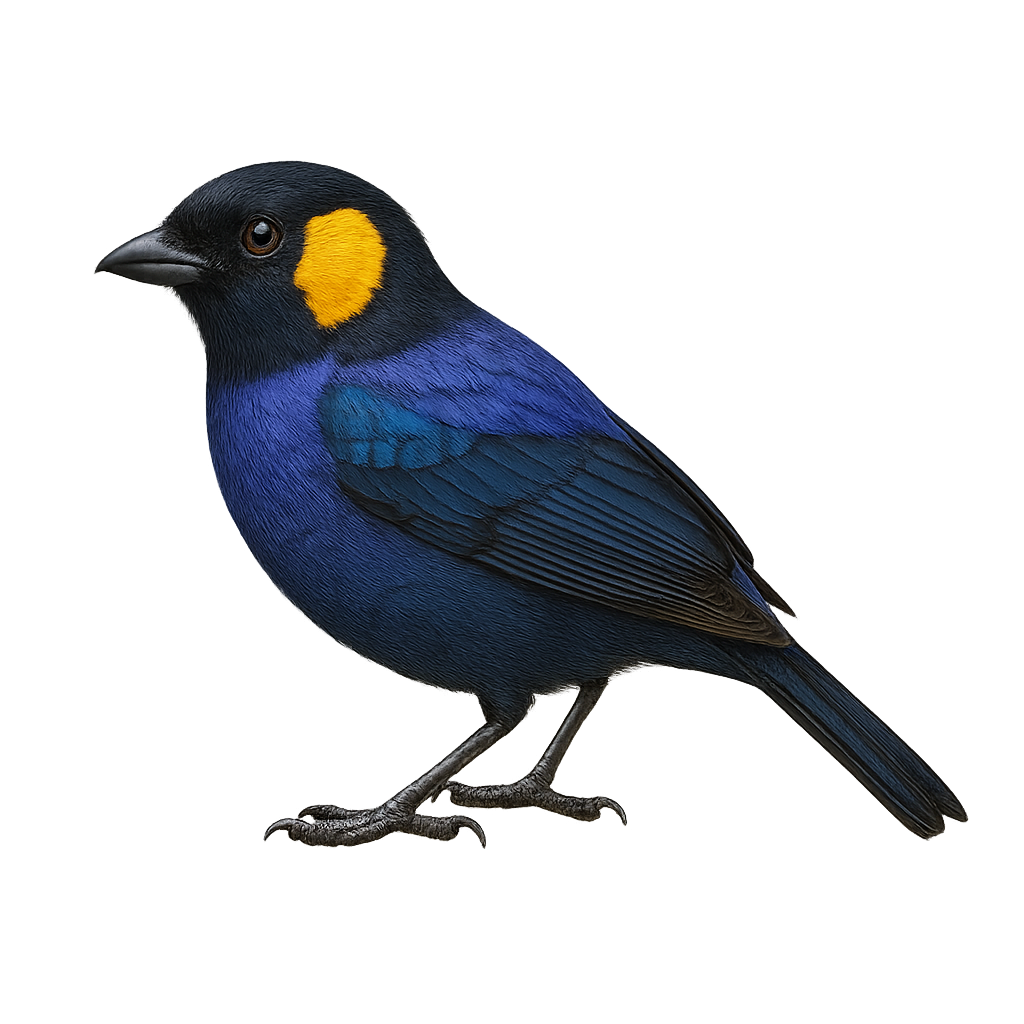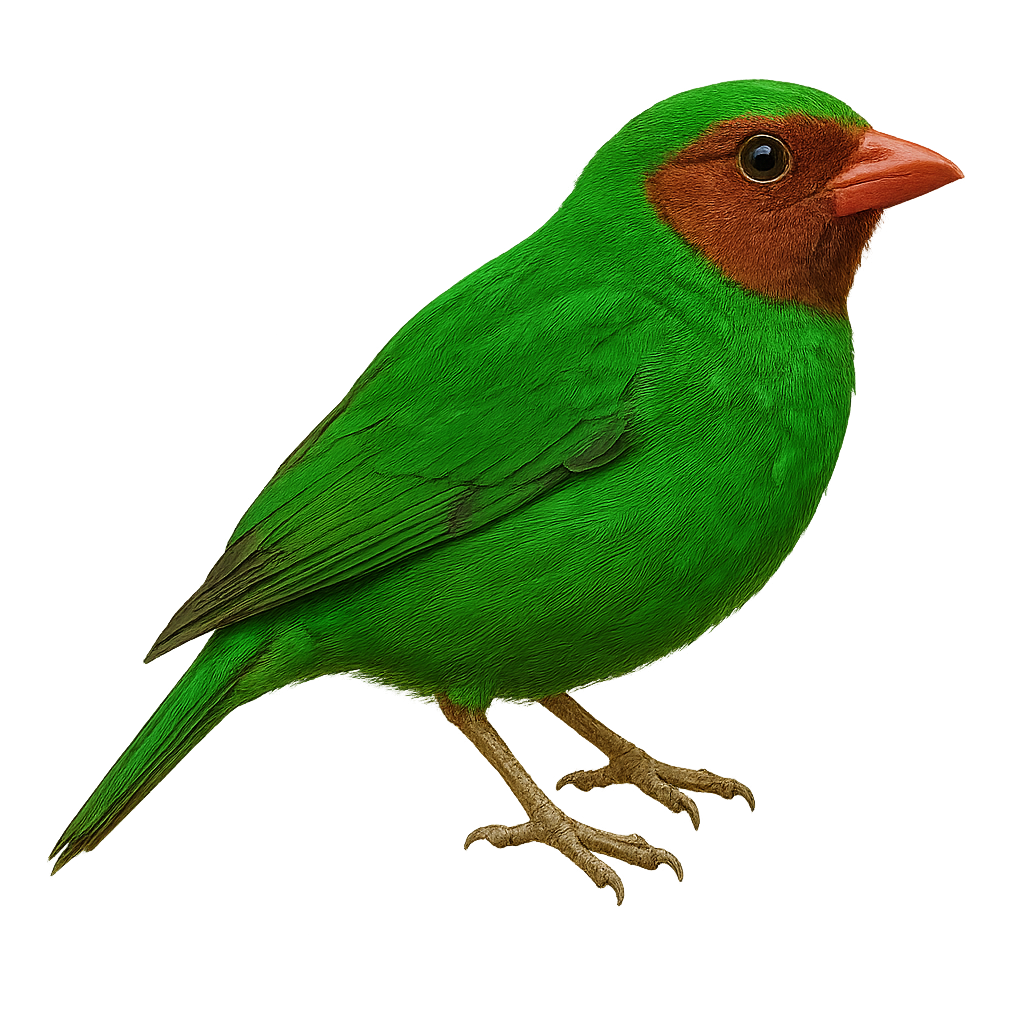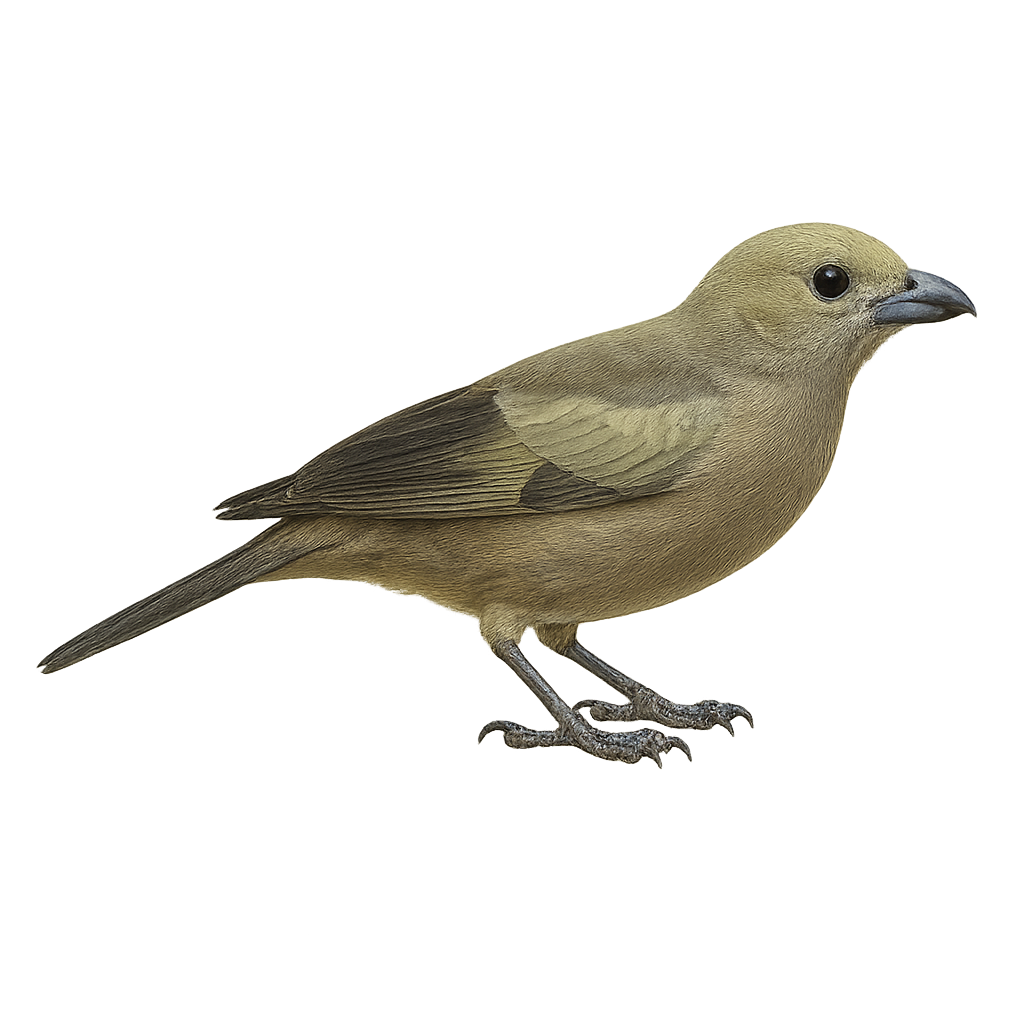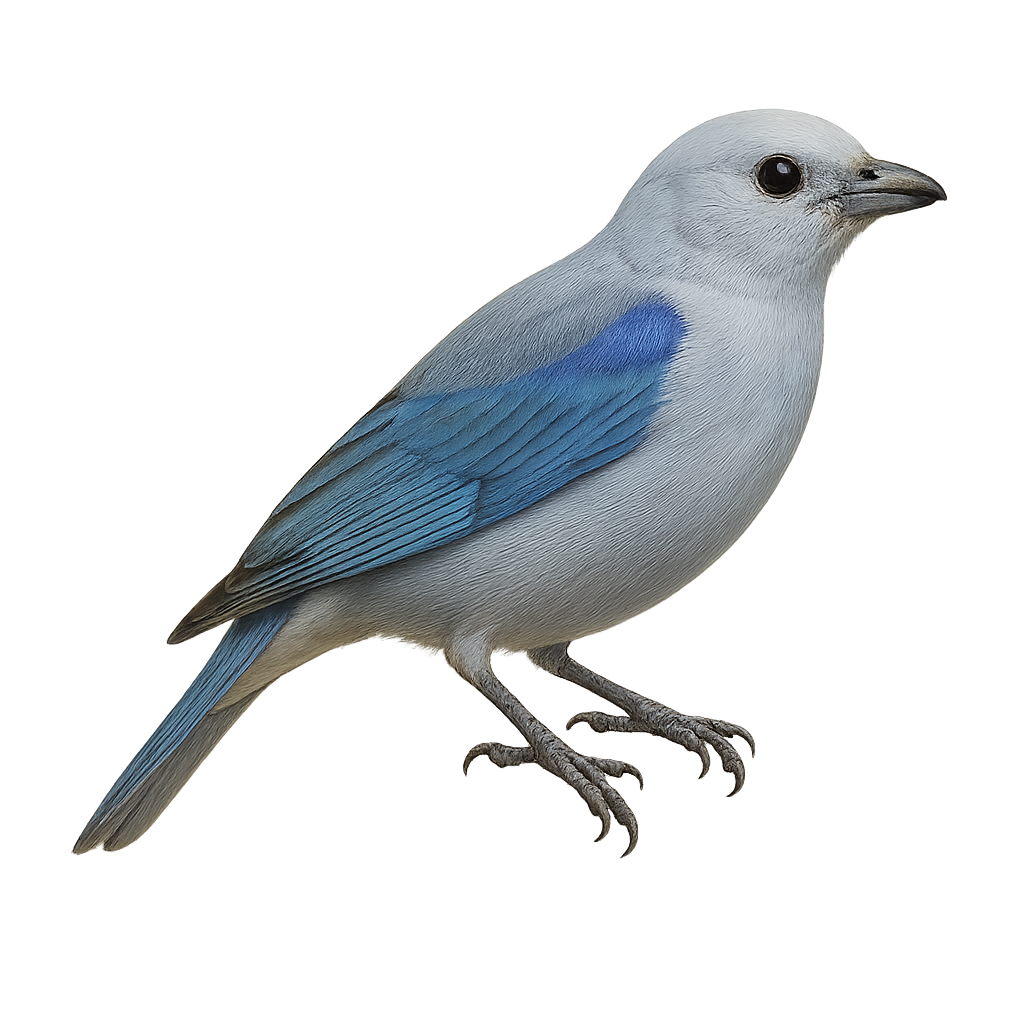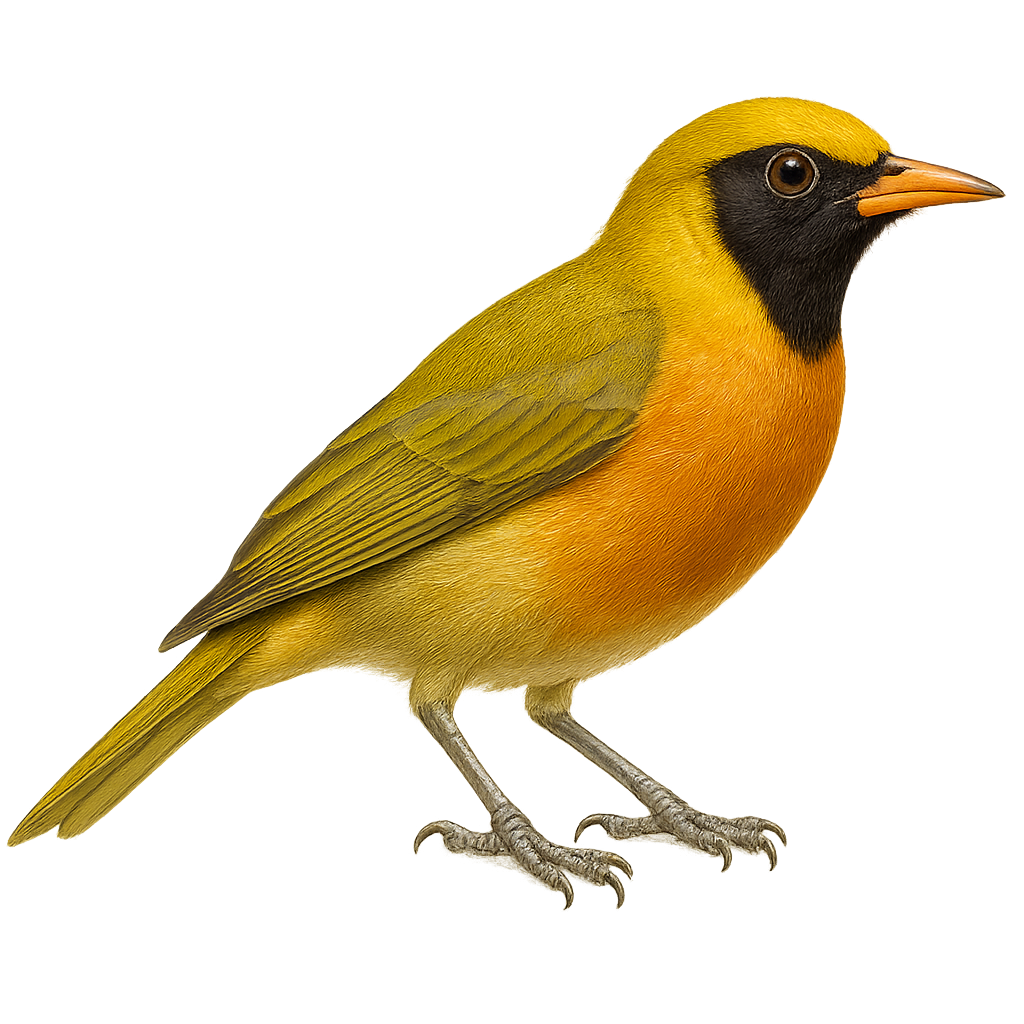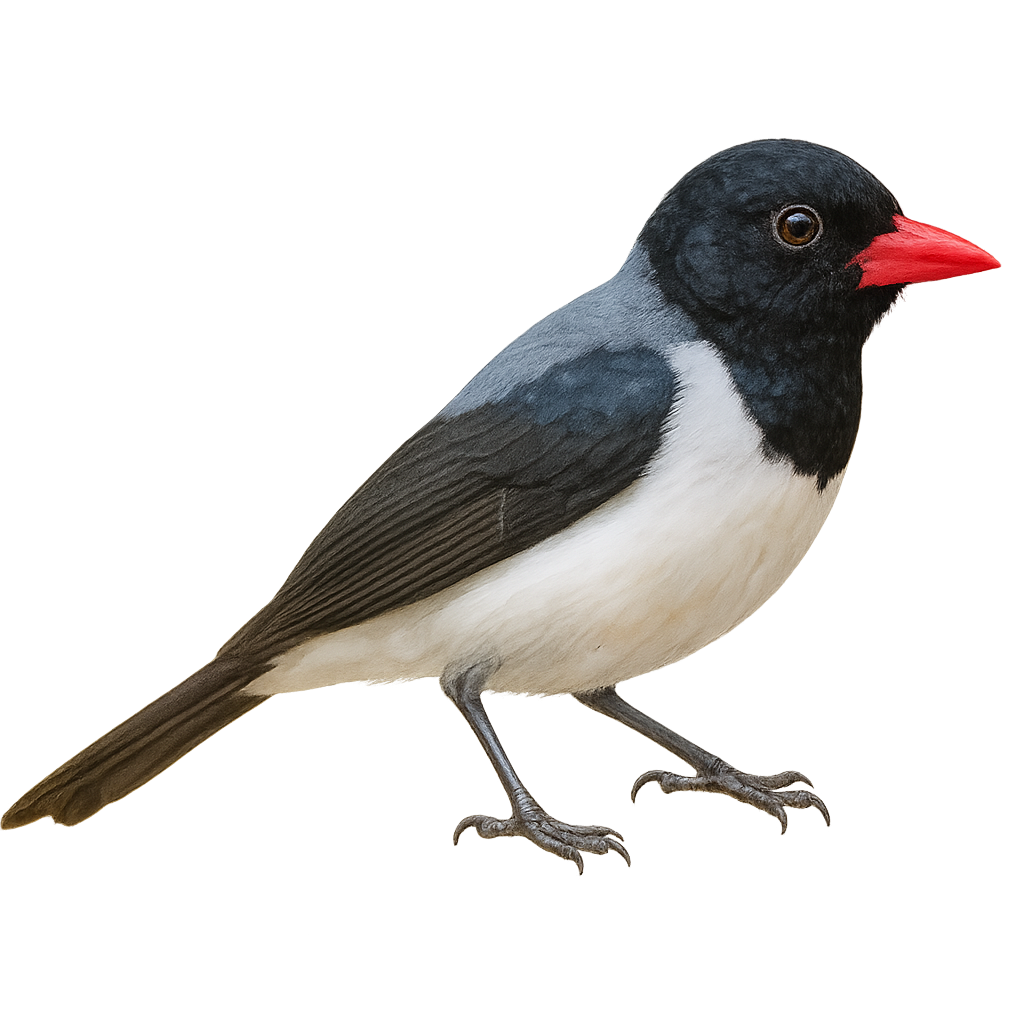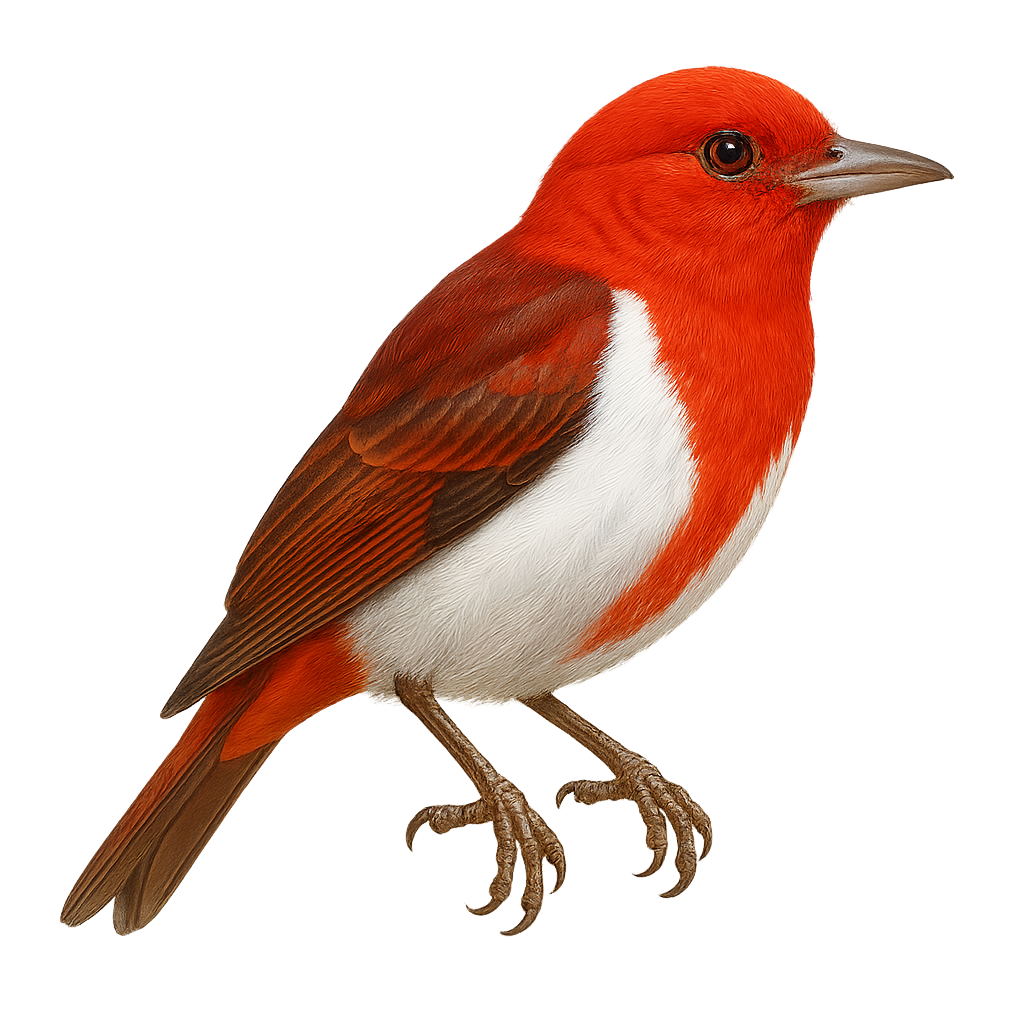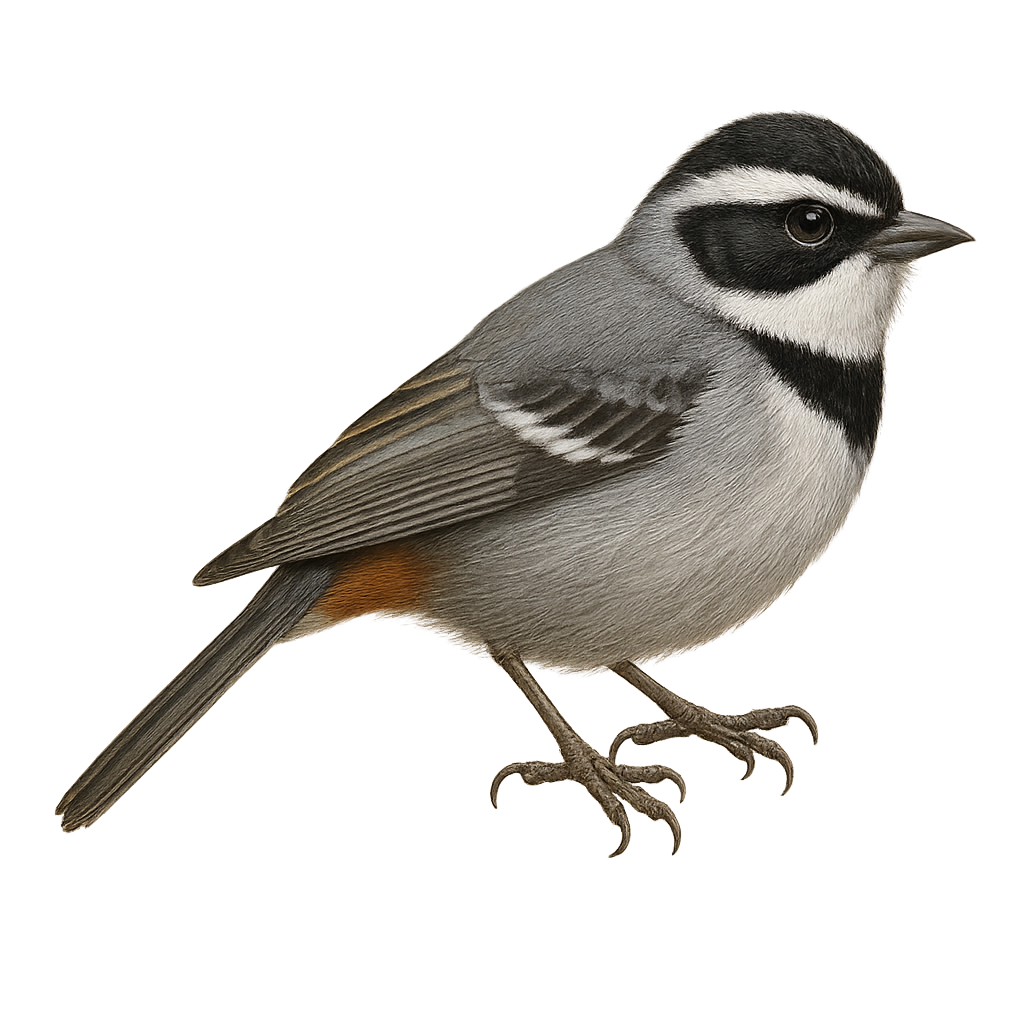The Passerini's Tanager, or Ramphocelus passerinii, is a colorful and fascinating bird found mainly in Central America, particularly in Costa Rica and Panama. This bird features a glossy black plumage with a bright red back, making it easily recognizable. Males and females show slight differences in coloration, with females having duller shades. They typically inhabit tropical rainforests, forest edges, and plantations, where they primarily feed on fruits and insects. Their song is soft and melodious, often heard at dawn. Although they are relatively tolerant of human presence, they prefer habitats with dense vegetation.
The Yellow-backed Tanager, or Hemithraupis flavicollis, is a small, lively songbird from the tropical forests of South America, easily recognized by its bright yellow back, black head (in males), and white underparts. It is found from eastern Panama through the Amazon Basin, the Guianas, and as far as southern Brazil. It lives in the canopy of humid forests, forest edges, and secondary growth. Active and sociable, it often joins mixed-species flocks and feeds on fruits, insects, and nectar. This adaptable species is common, and its population is considered stable across its range.
The Fawn-breasted Tanager, or Pipraeidea melanonota, is a colorful bird belonging to the Thraupidae family. It is recognized for its vibrant plumage, featuring a black back contrasting with a bright yellow belly and shades of blue on its wings and head. This bird is mainly found in the mountainous regions of South America, particularly in Argentina, Brazil, and Paraguay. It inhabits humid forests, forest edges, and shrublands. The Fawn-breasted Tanager is a diurnal, active, and sociable bird, often seen in small groups. Its diet primarily consists of fruits, nectar, and insects. Although not considered threatened, deforestation and habitat loss can impact its local populations.
The White-lined Tanager, or Tachyphonus luctuosus, is a medium-sized bird, measuring about 18 cm in length. It is easily recognizable by its glossy black plumage in males, with distinctive white lines on the wings, while females have a more subdued olive-brown hue. This bird is primarily frugivorous but also feeds on insects, making it an important player in seed dispersal and insect population control. It is mainly found in tropical rainforests, forest edges, and secondary wooded areas in Central and South America. Although quite common in its natural habitat, it is often difficult to observe due to its rather discreet and suspicious behavior.
The Rufous-chested Tanager, Thlypopsis pectoralis, is a bird from the Thraupidae family. It is mainly found in the mountainous regions of western South America, particularly in Peru and Bolivia. This bird is distinguished by its characteristic rufous chest, contrasting with its gray back and dark wings. It inhabits humid forests and shrublands at altitudes ranging from 1000 to 3000 meters. The Rufous-chested Tanager is a diurnal bird, often seen in small groups or pairs. Its melodious song and vibrant colors make it a favorite among birdwatchers and photographers. Although its conservation status is currently "least concern," deforestation could threaten its habitat in the future.
The Rufous-chested Tanager, or Thlypopsis ornata, is a small, colorful bird belonging to the Thraupidae family. It is primarily found in the mountainous regions of South America, particularly in Colombia, Ecuador, and Peru. This bird is notable for its vibrant plumage, featuring a rufous chest and wings with shades of gray and brown. It mainly inhabits humid forests and wooded areas, often at altitudes between 1500 and 3000 meters. The Rufous-chested Tanager is a diurnal bird, active mainly during the day, and feeds primarily on insects and fruits. Although generally suspicious, it can sometimes be seen in small groups.
The Ruby-crowned Tanager, or Tachyphonus rufus, is a medium-sized bird, about 18 cm long. It is easily recognizable by its glossy black plumage in males, with a bright red patch on the back, while females have duller, often brownish tones. This bird is primarily frugivorous but also feeds on insects. It is found in humid tropical forests, forest edges, and sometimes in gardens. It is widespread in South America, notably in Brazil, Argentina, and Paraguay. The Ruby-crowned Tanager is a sociable bird, often seen in small groups or pairs. Its song is melodious, composed of clear and repetitive notes.
The Red-crowned Ant-Tanager, Tachyphonus phoenicius, is a medium-sized bird known for its striking red head contrasting with its brownish body. It primarily inhabits the humid tropical forests of Central and South America. Often seen in small groups, this bird feeds on insects and fruits. Its melodious song and vibrant colors make it a favorite among birdwatchers. Although relatively common, its population is threatened by deforestation. Preserving its natural habitat is crucial for its survival. The Red-crowned Ant-Tanager plays a vital role in seed dispersal, contributing to the health of forest ecosystems.
The Orange-backed Tanager, Lanio aurantius, is a colorful and captivating bird native to the tropical forests of Central America. It is easily recognizable by its bright orange back contrasting with the rest of its black body. This bird measures about 18 cm in length and primarily feeds on fruits, insects, and small invertebrates. It usually lives in small groups or pairs, often in the company of other tanager species. The Orange-backed Tanager is an active and vocal bird, emitting a variety of songs and calls to communicate with its peers. Although its habitat is threatened by deforestation, it remains relatively common in some areas.
The Yellow-winged Tanager, or Thraupis abbas, is a colorful and fascinating bird found primarily in the tropical and subtropical forests of Central America. This medium-sized passerine boasts a striking plumage, with distinctive yellow wings contrasting against its blue-gray body. Males and females exhibit little sexual dimorphism, although males are often slightly more vibrant. The Yellow-winged Tanager is a sociable bird, often seen in small groups, feeding mainly on fruits but also on insects. Its melodious and varied song is a delight for birdwatchers. Although relatively common in its natural habitat, it is essential to preserve the forests where it resides to ensure its long-term survival.
The Tawny-crested Tanager, or Heterospingus xanthopygius, is a small, colorful songbird of lowland tropical rainforests along the Pacific coast of southern Costa Rica and western Panama. It is recognized by its reddish-brown eyebrow stripe, olive back, pale underparts, and bright yellow rump. Active in the canopy, it often joins mixed-species flocks and feeds on fruits, insects, and occasionally nectar. Though discreet, it is striking and relatively little-known outside its limited range. Its population is considered stable but sensitive to habitat fragmentation.
The Orange-headed Tanager is a small, colorful bird found mainly in South America. It is recognizable by its bright orange head contrasting with its gray and brown body. This passerine frequents humid tropical forests, forest edges, and sometimes more open wooded areas. Often seen in small groups or pairs, it feeds primarily on insects and fruits. Although its habitat is relatively stable, it is sometimes threatened by deforestation. The Orange-headed Tanager is an active and agile bird, often seen hopping from branch to branch in search of food. Its breeding period varies by region, but it is generally not very shy, making it accessible for observation.
The Paradise Tanager, known for its vibrant plumage, is a fascinating bird from the tropical forests of South America. Its head is a bright green, contrasting with a turquoise blue body and black wings. It measures about 13 to 15 cm in length and weighs between 15 and 20 grams. This bird primarily feeds on fruits, insects, and nectar, playing a crucial role in pollination and seed dispersal. It lives in social groups and is often seen in the company of other tanager species. Its song is melodious, composed of varied and pleasant notes. Although its habitat is threatened by deforestation, it is still widely distributed and not considered endangered.
The Rufous-capped Warbler, or Thlypopsis ruficeps, is a small, colorful bird primarily found in the humid forests and wooded areas of South America. Its distinctly rufous head contrasts with its more neutral-toned body, making it a captivating sight for birdwatchers. Often seen in small groups, it moves nimbly through foliage in search of insects and fruits. Although discreet, its melodious song often betrays its presence. This tanager is a perfect example of birds adapting to specific ecological niches, using its plumage for camouflage while exploiting available food resources in its habitat.
The White-winged Tanager, or Piranga leucoptera, is a colorful bird primarily inhabiting the tropical and subtropical forests of Central and South America. This tanager is distinguished by its vibrant plumage, with males displaying a striking red contrasted by distinctive white wings, while females exhibit more subdued shades of yellow and olive. Measuring about 18 cm in length, this bird is often seen in pairs or small groups, feeding mainly on fruits and insects. Although relatively discreet, its melodious song and vivid colors make it easily noticeable in its natural habitat.
The Crimson-collared Tanager, scientifically known as Ramphocelus sanguinolentus, is a striking bird found primarily in Central America, particularly in Mexico, Honduras, and Costa Rica. This bird is noted for its vibrant plumage, featuring a bright red back contrasted with its black head and wings. Measuring about 19 cm in length, it is often spotted in tropical rainforests and wooded areas. Its diet mainly consists of fruits, berries, and insects. The Crimson-collared Tanager is a sociable bird, often seen in small groups or pairs. Although not considered threatened, deforestation poses a potential threat to its natural habitat.
The Edwards's Tanager, scientifically known as Bangsia edwardsi, is a vibrant and captivating bird native to the humid montane forests of Colombia and Ecuador. This medium-sized passerine boasts a striking plumage with shades of blue and green that catch the eye. Often seen in small groups, it primarily feeds on fruits and insects. Its natural habitat ranges from 1,200 to 2,400 meters in altitude, where it plays a crucial role in seed dispersal, aiding forest regeneration. Although its conservation status is concerning, efforts are underway to protect its habitat and ensure its long-term survival.
The Reinhardt's Tanager is a colorful bird belonging to the Thraupidae family. It is mainly found in the humid montane forests of South America, particularly in Colombia and Ecuador. This bird is distinguished by its vibrant plumage, featuring shades of blue, yellow, and black. It is often seen in small groups, feeding on fruits and insects. Although its habitat is relatively stable, deforestation poses a potential threat to its population. Reinhardt's Tanager is a fascinating bird for ornithologists and nature enthusiasts, thanks to its striking colors and social behavior.
The Grass-green Tanager, or Chlorornis riefferii, is a vibrant and fascinating bird primarily found in the humid forests of the Andes. With its bright green plumage, it is distinguished by a reddish head and a robust beak. This bird measures about 20 cm in length and feeds mainly on fruits, insects, and nectar. It is often seen in small groups, moving nimbly through dense foliage. Although its habitat is relatively stable, deforestation poses a potential threat. The Grass-green Tanager is a symbol of Andean biodiversity and plays a crucial role in seed dispersal, contributing to the health of its ecosystem.
The Palm Tanager, or Thraupis palmarum, is a medium-sized bird, measuring about 18 cm in length. It is characterized by its predominantly olive-green plumage, with lighter shades on the wings and tail. Its head has a slightly grayer hue, contrasting with the rest of the body. This bird is often seen in small groups, feeding on fruits, insects, and nectar. It is common in gardens, plantations, and secondary forests, where it plays a crucial role in seed dispersal. Its presence is often marked by its soft and melodious song.
The Scarlet Tanager, or Piranga olivacea, is a bird with striking plumage, especially in males who display a vivid red body contrasting with black wings and tail. Females, on the other hand, have more subdued colors, with olive-green plumage and dark wings. This migratory bird is primarily found in North America during the breeding season, favoring deciduous and mixed forests. In winter, it migrates to Central and South America. The Scarlet Tanager feeds mainly on insects and fruits, which it skillfully captures in the canopy. Its melodious and fluid song is often heard before the bird is seen, as it frequently hides in dense foliage.
The Bishop Tanager is a small, colorful bird found primarily in the tropical forests and wooded areas of Central and South America, notably in Costa Rica, Panama, Colombia, and Venezuela. It typically measures about 18 cm in length and weighs between 20 and 30 g. Its plumage is especially vibrant, with shades of green, yellow, and red, giving it a striking appearance, which is why it is named as such. The Bishop Tanager is frugivorous, primarily feeding on fruits, berries, and seeds, but it can also eat insects. This bird is known for its social behaviors, living in small groups or pairs, and is often observed moving through trees in search of food. While its population remains stable, it is sometimes threatened by deforestation and the loss of its natural habitat.
The Blue-gray Tanager is a medium-sized bird, about 18 cm in length. It is easily identifiable by its bright blue-gray plumage, with lighter shades on the belly and slightly darker wings. Its eyes are black, and it has a short, conical beak suited for its diet mainly consisting of fruits, but also insects. It is primarily found in tropical and subtropical forests, wooded areas, and urban gardens in Central and South America. Sociable by nature, it often lives in small groups and can be seen feeding in the canopy. Its presence is often marked by its melodious and repetitive song.
The Blue-and-yellow Tanager, Rauenia bonariensis, is a vibrant bird native to South America. It is easily identified by its striking blue back and bright yellow belly. This bird measures about 15 cm in length and weighs between 20 and 30 grams. It primarily inhabits subtropical and tropical moist forests, but can also be found in shrublands and gardens. The Blue-and-yellow Tanager is a social bird that feeds mainly on fruits, insects, and nectar. It is often seen in small groups or pairs. Its breeding season varies by region, but it is generally active during the warmer months.
The Guira Tanager is a small, colorful bird primarily found in South America, particularly in Brazil, Argentina, and Paraguay. It is easily recognizable by its vibrant plumage, featuring shades of bright yellow, black, and white. Males and females exhibit differences in coloration, with males generally being more vivid. This tanager inhabits tropical rainforests, forest edges, and sometimes open wooded areas. It feeds mainly on fruits, insects, and nectar, playing a significant role in seed dispersal and pollination. The Guira Tanager is a sociable bird, often seen in small groups or pairs, and is known for its melodious and varied songs.
The White-rumped Tanager, or Cypsnagra hirundinacea, is a distinctive bird of the South American savannas. It is characterized by its black and white plumage, with a prominent white patch on the rump, especially visible in flight. This bird measures about 16 cm in length and weighs between 20 and 25 grams. It is often seen in small groups, feeding mainly on insects caught on the ground or in bushes. Its voice is a mix of whistles and trills, often heard at dawn. The White-rumped Tanager is a resilient bird, capable of adapting to modified environments, although it prefers open and semi-open habitats.
The Fulvous Shrike-Tanager, scientifically known as Lanio fulvus, is a medium-sized bird belonging to the Thraupidae family. It is characterized by its predominantly tawny plumage, with shades of brown and gray, and a sturdy beak suited for its varied diet. Found mainly in the humid tropical forests of Central and South America, it feeds on fruits, insects, and occasionally small vertebrates. This bird is often seen in groups, which helps it protect itself from predators. Although its habitat is threatened by deforestation, the Fulvous Shrike-Tanager is currently classified as "Least Concern" by the IUCN.
The Red-billed Pied Tanager, or Lamprospiza melanoleuca, is a fascinating bird distinguished by its contrasting black and white plumage. This small passerine is primarily found in the tropical rainforests of South America, particularly in Brazil, Bolivia, and Peru. It prefers dense habitats where it can feed on fruits, insects, and small invertebrates. The Red-billed Pied Tanager is often seen in small groups, actively moving through the canopy in search of food. Although its song is not particularly melodious, it plays an essential role in communication among group members. Its ability to adapt to different forest types makes it a resilient bird in the face of environmental changes.
The Scarlet-and-white Tanager, or Chrysothlypis salmoni, is a bird from the Thraupidae family, primarily found in the humid montane forests of Central and South America. This small passerine is notable for its striking plumage: males have a vivid red head contrasting with a white body, while females display more subdued tones. They typically live in pairs or small groups, feeding on fruits, insects, and nectar. Their melodious and varied song is often heard at dawn and dusk. Although their habitat is threatened by deforestation, they remain relatively common in some protected areas.
The Ringed Warbling-Finch, or Microspingus torquatus, is a small passerine bird belonging to the Thraupidae family. It is primarily found in the arid and semi-arid regions of South America, particularly in Argentina, Bolivia, and Paraguay. This bird is characterized by its bluish-gray plumage with a distinctive black collar around the throat. The wings and tail exhibit shades of brown and black. The Ringed Warbling-Finch is a diurnal bird, often seen in small groups or pairs, feeding mainly on seeds and insects. Known for its melodious song, it is often heard at dawn. Although relatively common in its natural habitat, it is crucial to protect its living areas from environmental threats.


